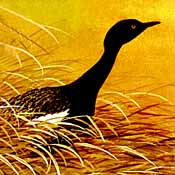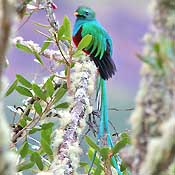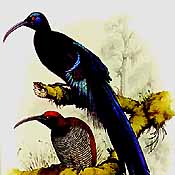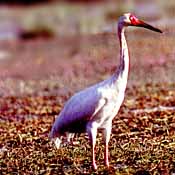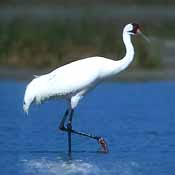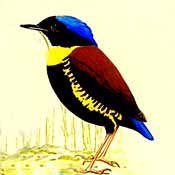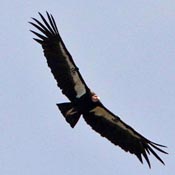# |
Species [range] |
Photo/art [see credits];
all photos taken in the wild |
Summary of reasons for this choice |
DR seen? |
21 |
Bengal Florican
Eupodotis bengalensis
[s. Asia] |
|
Both floricans (this and Lesser Florican E. indica) of the Indian subcontinent are highly endangered. This impressive bird exists only in fragmentary wet grasslands on the border of Nepal & India, and a tiny population is in Cambodia and adjacent Vietnam. The Lesser may be rarer but this is bigger and more spectacular; I also admit to admiring the way its name rolls off the tongue. Both this species and Lesser Florican have amazing courtship dances. |
Yes |
22 |
Resplendent Quetzal
Pharomachrus mocinno
[Central America] |
|
Any quetzal is great, but the incredibly long train of this species is in a world apart. There are a variety of spots were it can be found from s. Mexico to Costa Rica to w. Panama but it is always special to see the brilliant green bird outshining the great green canopy in which it exists, and then the male does incredible courtship flights above the canopy! It is the national bird of Guatemala and many legends are associated with it. |
Yes |
| 23 |
any Monal
Lophophorus sp.
[Himalayas] |
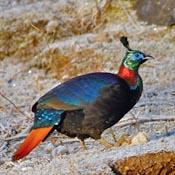 |
All 3 monals were on my initial "top 50" list in 1974, as were all 4 tragopans, both argus — big pheasants are just so impressive. Some early readers opined that was "too many chickens." So I've cut back. Still, the drop-dead gorgeous male monals, plus the difficulty in seeing them in alpine meadows near coniferous and Rhododendron forests, renders them highly desirable. Himalayan Monal L. impejanus (my photo, left) occurs from Pakistan to Bhutan. Sclater's Monal Lophophorus sclateri & Chinese Monal L. lhuysii reside farther east; most of their ranges are in China. |
Yes; 1 of 3 |
24 |
Black Sicklebill
Epimachus fastuosus
[New Guinea] |
|
There are 4 sicklebills in New Guinea, each one spectacular, each one hard to find. Brown Sicklebill E. meyeri is the "easiest" but Black Sicklebill is difficult, shy and scarce. It occurs high in the mountains, including the Arfaks, where it is restricted to upper montane cloud forest. Its absolutely unbelievable display posture was captured in the BBC film Attenborough in Paradise. Black-billed E. albertisi & Pale-billed E. bruijnii are the other subperb sicklebills — oh, to see them all! |
No |
25 |
Siberian Crane
Grus leucogeranus
[c. Asia] |
|
The gigantic white crane of Asia breeds in two distinct populations in n. Russia. The eastern flock, which holds 95% of the world's 2500 birds, winters in China; the western birds used to migrate to India and were once the headline species wintering at Bharatpur in Rajasthan. Now the western flock is almost gone. Red-crowned Crane (Japanese) Grus vipio would be another excellent choice. It is the Old World's second rarest crane, intimately woven into Japanese culture, and I'm told that seeing a flock of dancing cranes on a wintry day is a great spectacle. |
No |
26 |
Whooping Crane
Grus americana
[c. North America] |
|
Nesting in Wood Buffalo NP, Canada, then migrating across the Great Plains to reach its wintering grounds in coastal Texas, the Whooping Crane is one of the world's rarest birds. The population fluctuates at around 80–100 birds; efforts to establish a second flock are also working. It is a huge, stately, and impressive crane but is not hard to see: one can take a boat ride from Aransas or look from a tower. It is a North American success story that the species survives at all. |
Yes |
27 |
Hooded Grebe
Podiceps gallardoi
[s. South America] |
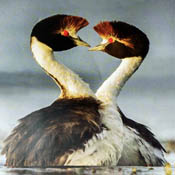 |
Hooded Grebe is a beautiful small grebe with elaborate courtship dances and displays [only a couple other grebes have synchronized courtship dances on the water]. It is an Argentine breeding endemic on isolated lakes in the remote barrens of Patagonia. The entire population winters (Apr-Aug) on coastal lakes and estuaries in s.e. Argentina, with just a few records for s. Chile. Grebes are an ancient group of foot-propelled divers, but 3 resident species in 3 genera went extinct in the 1980s. Hooded was only discovered ~ 50 years ago; it is now critically endangered. |
Yes |
28 |
Gurney's Pitta
Pitta gurneyi
[southeast Asia] |
|
On the verge of extinction in peninsular Thailand, its tragic decline and then hopeful re-discovery in extreme s. Burma have been features of Oriental headlines this decade. Before that it had "disappeared" for 34 years without any reports. It is thought that there are now less than 30 pairs left; local guides have both helped and hindered the bird's recovery. This has become a primary conservation issue for much of southeast Asia. |
No |
29 |
California Condor
Gymnogyps californianus
[w. United States] |
|
Evoking a feeling of wilderness and pre-history, they nearly went extinct in the 1980s. All wild condors were trapped for a captive breeding program by 1987. Dozens have been released into the wild in s. California wilderness, along the Big Sur coast, and in the Grand Canyon. The first active nests were in 2002 and new youngster are now wild-bred annually. They can be seen now at various sites, including Pinnacles NP and along the Big Sur coast in c. California [see Condors in Monterey page]. |
Yes |
30 |
Plains-Wanderer
Pedionomus torquatus
[interior Australia] |
|
The thrid of six monotypic families that made the "top 50," this secretive bird exists only in a few isolated sparse grasslands in the interior of Australia. Its taxonomic affinities remain uncertain. Can be exceptionally difficult to locate without local guides; see my "Plains-Wanderer" page for more details. |
Yes |


